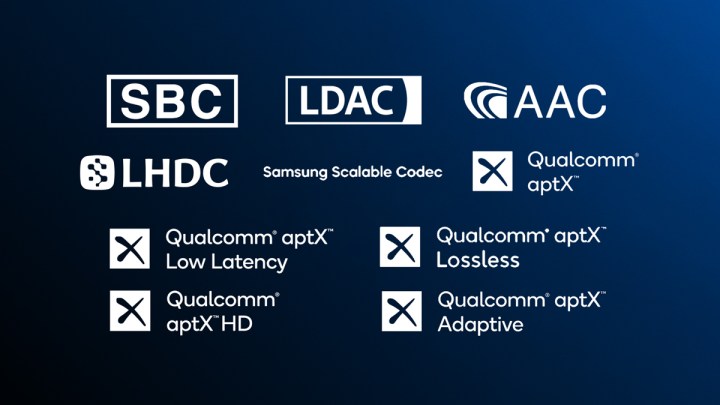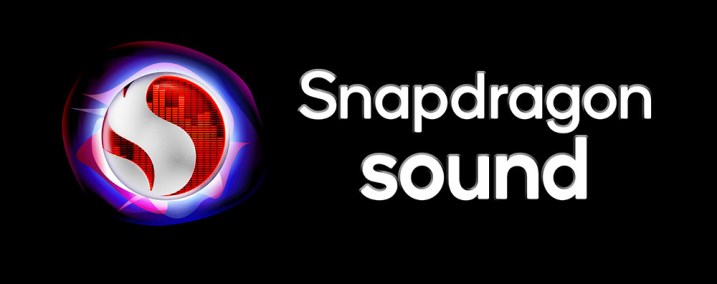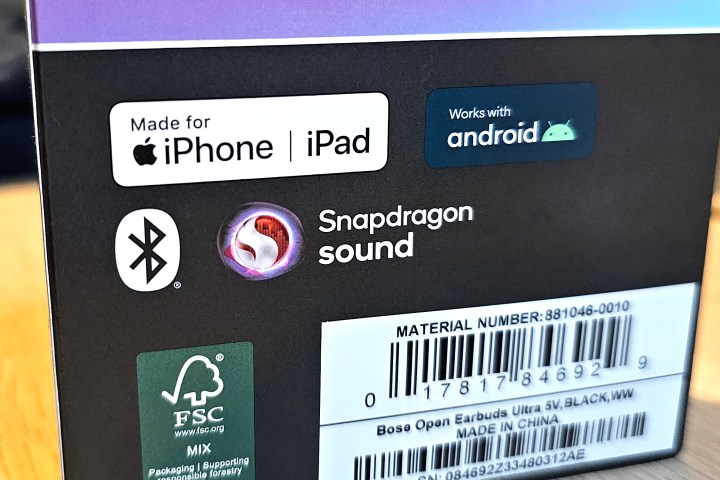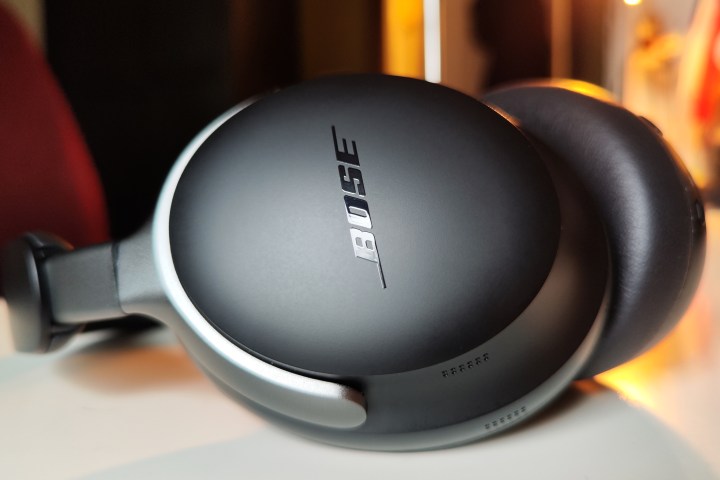So, you’re checking out a pair of headphones online or at your local Best Buy and its got this swooshy red-and-white logo in the description that says “Snapdragon Sound,” and you wonder, “huh, what is that?” Then you see your new Android smartphone has the same logo. The plot thickens. What does it all mean?
In a world where the advanced features of our wireless headphones or earbuds rely on matching capabilities within our smartphones (which the phones may or may not have), Qualcomm’s Snapdragon Sound is an attempt to bring order to the chaos. It’s a promise that things will just work as long as all of your products bear the same Snapdragon Sound logo. Or at least that’s the idea.
But what exactly is Snapdragon Sound, and does it really eliminate compatibility concerns? Let’s dive into everything you need to know.
Codec confusion

Before we get into what Snapdragon Sound is, let’s quickly recap what led to the creation of this brand. It started with Bluetooth audio codecs — the algorithms responsible for transporting audio wirelessly.
Bluetooth audio codecs are at once a brilliant technology, and a royal pain in the butt. Without audio codecs, we wouldn’t be able to use Bluetooth to listen to anything — uncompressed music is just too big to fit inside the limited bandwidth of a Bluetooth connection.
As long as your phone (or computer or tablet) and your headphones (or earbuds or speaker) are both equipped with the same codec, they’ll work just fine together. If it’s not in both places, it’s like a language that only one device knows how to speak.
Decades ago, at the dawn of Bluetooth audio, this wasn’t an issue. There was just one audio codec —called SBC — and every Bluetooth audio device supported it. They were (and still are) required to support it if they want to participate in the Bluetooth audio ecosystem.
However, SBC is a bare-bones codec. It was born long before smartphones could stream lossless, hi-res audio from anywhere in the world, in a time when highly compressed MP3s ruled the portable audio landscape. If you use SBC to listen to lossless or hi-res audio, a significant amount of detail will be lost.
Over the years, various entities like Sony, Qualcomm, Samsung, and Fraunhofer IIS have steadily introduced new audio codecs, each of which promised improvements over SBC. As of 2024, there are more than 14 of them, and several are designed to preserve far more of the high-quality audio we now have access to.
With that expansion of the Bluetooth codec universe came compatibility problems. Since Bluetooth audio devices aren’t required to support these better-than-SBC codecs, it has fallen to buyers to check that both of their chosen devices support the same ones.
All about aptX

This issue became particularly problematic for companies that chose to use Qualcomm’s family of aptX codecs. There are now five “flavors” of aptX: Classic aptX came first, followed by aptX HD, then aptX Low Latency (aptX LL) and aptX Adaptive. Most recently, Qualcomm added aptX Lossless.
We won’t get into the differences between these aptX flavors here, but if you’re curious, check out our in-depth Qualcomm aptX explainer — it has all of the answers.
Newer aptX-capable headphones and earbuds usually support aptX Adaptive, which is backward-compatible with classic aptX and aptX HD. However, even though all Android phones running Android 8.0 or higher support aptX and aptX HD, aptX Adaptive and aptX Lossless are only available on select Android phones that use Qualcomm’s processors. Some aptX Adaptive products are limited to 48kHz sampling rates, while others can support up to 96kHz.
Meanwhile, aptX Low Latency is incompatible with the antenna structure on phones, so the only way to take advantage of it is via a USB dongle or other third-party device. And aptX HD? You’ll find it on Bluetooth headphones, but only a tiny number of true wireless earbuds provide it, due to reliability issues.
To make matters even more confusing, Apple has never supported Qualcomm’s aptX family on its iPhones.
The worst part about this codec chaos is that, as a humble buyer of these devices, you may not even realize it when hardware incompatibility has robbed you of the benefits of these new codecs. Since SBC is always present, you’ll still get audio on your chosen headphones. Just not at the level of audio quality you thought you were going to get.
Snapdragon Sound — one brand to rule them all?

Qualcomm eventually realized it couldn’t rely on manufacturers and buyers to ensure that aptX-equipped products were being purchased and used in ways that would guarantee compatibility, and thus deliver on the lofty expectations set by the promise of better codecs.
It decided that a single, catchy brand was the answer and created the Snapdragon Sound program. The name strongly suggests that this is yet another codec or technology (kind of like the “Intel Inside” marketing campaign from the 1990s), but it’s not.
Instead, it’s intended to signify when two products will work together reliably and with a certain set of guaranteed features. If you see “Snapdragon Sound” on a set of earbuds and on a smartphone, you can breathe a sigh of relief, knowing that they will “just work.”
Or at least that’s how it began.
In 2021, when Snapdragon Sound was officially launched, it was with a guarantee of five key features, which had all been tested and certified to work by Qualcomm:
- AptX Adaptive at 24-bit/48kHz
- AptX Adaptive at 24-bit/96kHz
- Low latency mode when gaming
- AptX Voice (super wideband voice) when on a call
- Qualcomm Bluetooth High Speed link
These five features meant that your Snapdragon Sound combo would deliver the best possible audio and call quality, with low latency — similar to that of aptX LL — when needed.
The concept, while foreign to buyers who were by now getting used to the idea of scanning specs to find the codecs they wanted, was a good one.
The many flavors of Snapdragon Sound

Then things began to change. In early 2022, Qualcomm introduced aptX Lossless, a codec that can deliver bit-perfect CD-quality audio at 16-bit/44.1 kHz — a first for the Bluetooth audio world. AptX Lossless was (and still is) an exclusive feature of Snapdragon Sound, but it’s an optional feature.
In other words, some Snapdragon Sound phones and wireless audio products support aptX Lossless and some don’t. Qualcomm elected to keep the Snapdragon Sound brand unchanged. It didn’t add a version number or a tag to indicate the presence of aptX Lossless, e.g. “Snapdragon Sound Plus” or “Snapdragon Sound 2.0,” which meant that for aptX Lossless, manufacturers and buyers were right back to checking product specs.
Near the end of 2022, the company announced it was expanding Snapdragon Sound further, with the addition of head-tracked spatial audio, an enhanced version of aptX Lossless that goes up to 48kHz, and improved latency with backchannel voice for in-game experiences.
Once again, it chose to make these optional for Snapdragon Sound participants.
Then, at some point during 2024 — Qualcomm won’t say exactly when — it quietly changed the original five Snapdragon Sound features (the ones that were supposed to be the minimum on any Snapdragon Sound-branded product).
As of the fall of 2024, Snapdragon Sound products must support:
Either
- AptX Adaptive at 24-bit/96kHz
Or
- AptX Lossless
Plus:
- Low Latency Gaming mode
- Qualcomm High Speed link
The following features are optional add-ons:
- aptX Voice (super wideband voice)
- Head-tracked spatial audio
- Stereo recording
And despite this significant restructuring of mandatory versus optional features, the Snapdragon Sound name and logo have remained the same since they debuted. Qualcomm expects each manufacturer to specify the features their products support.
When, in 2022, it looked like Qualcomm would simply expand the number of features under the Snapdragon Sound brand, there was something of a silver lining. Your new aptX Lossless Snapdragon Sound headphones might not give you aptX Lossless if you used them with an older Snapdragon Sound phone, but they would still be backward compatible with the five previous Snapdragon Sound features.
Unfortunately, in shifting the mandatory features, Qualcomm has degraded that promise of backward compatibility. Take the Bowers & Wilkins Pi8 wireless earbuds as an example. They bear the Snapdragon Sound brand and they feature aptX, aptX Adaptive, and aptX Lossless, however they don’t support aptX Voice.
Fragmentation frustration

Today’s Snapdragon Sound landscape looks a lot like the pre-Snapdragon Sound era. If you want to know which features a Snapdragon Sound product offers, you’ll need to pay close attention to the specifications.
Qualcomm’s aptX website remains the only resource that we’re aware of that lists all available Snapdragon Sound products. Its database can be filtered by product type (wireless earbuds, headphones, smartphones, tablets, speakers, and transmitters/receivers) and by aptX flavor (including Snapdragon Sound).
The only problem is that it hasn’t kept pace with the changing Snapdragon Sound feature set. You can see Snapdragon Sound products and those that additionally offer aptX Lossless, but there’s no way to filter by Qualcomm’s newer optional features like spatial audio. Perhaps more importantly, there’s no way to filter for previously mandatory features like aptX Voice.
For a North American audience, the Snapdragon Sound landscape is tricky.
There are now several decent options in both wireless earbuds and wireless headphones, from brands like Sennheiser, Bose, Shure, Denon, and Earfun. Many are priced above $300, but some cost less than $100.
Smartphones are a different story. As we indicated earlier, there are no Snapdragon Sound iPhones. Google’s Pixel phones aren’t Snapdragon Sound compatible and neither are Samsung’s. The only companies we can find with Snapdragon Sound models are Motorola, Nothing, and Sony.
Elsewhere in the world, the selection is better: Xiaomi, Asus, Sony, ZTE, Vivo, Nubia, Sharp, and BlackShark.
Is it easier to buy wireless audio products now that we have Qualcomm’s Snapdragon Sound program? Perhaps. It’s certainly easier to identify the products that will deliver some of Qualcomm’s aptX benefits, like hi-res or lossless audio.
But as a true it-just-works brand that alleviates us from the need of scouring specifications? Sadly, it’s still very much buyer beware.




